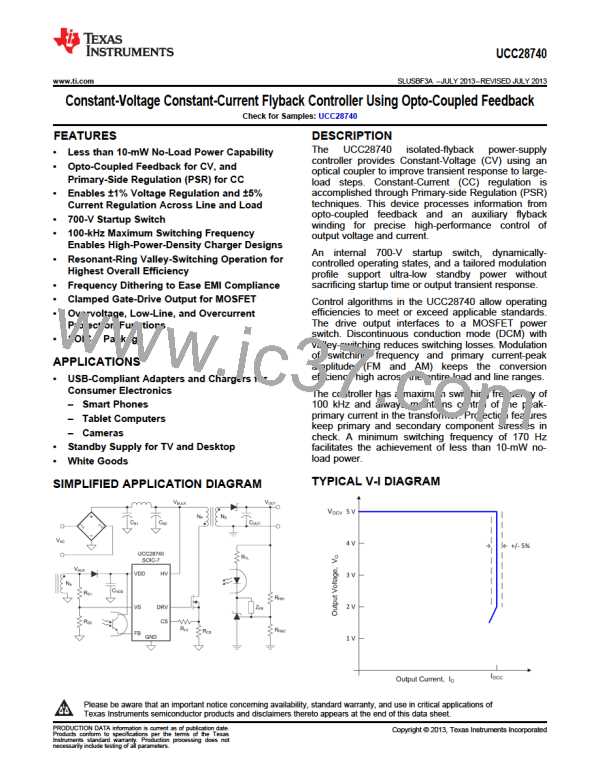UCC28740
SLUSBF3A –JULY 2013–REVISED JULY 2013
www.ti.com
Standby Power Estimate and No-Load Switching Frequency
Assuming minimal no-load standby power is a critical design requirement, determine the estimated no-load
power loss based on an accounting of all no-load operating and leakage currents at their respective voltages.
Close attention to detail is necessary to account for all of the sources of leakage, however, in many cases,
prototype measurement is the only means to obtain a realistic estimation of total primary and secondary leakage
currents. At present, converter standby power is certified by compliance-agency authorities based on steady-
state room-temperature operation at the highest nominal input voltage rating (typically 230 Vrms).
Equation 6 estimates the standby power loss from the sum of all leakage currents of the primary-side
components of the converter. These leakage currents are measured in aggregate by disconnecting the HV input
of the controller from the bulk-voltage rail to prevent operating currents from interfering with the leakage
measurement.
(6)
Equation 7 estimates the standby power loss from the sum of all leakage and operating currents of the
secondary-side components on the output of the converter. Leakage currents result from reverse voltage applied
across the output rectifier and capacitors, while the operating current includes currents required by the shunt-
regulator, optocoupler, and associated components.
(7)
Equation 8 estimates the standby power loss from the sum of all leakage and operating currents of the auxiliary-
side components on the controller of the converter. Leakage currents of the auxiliary diode and capacitor are
usually negligible. The operating current includes the wait-state current, IWAIT, of the UCC28740 controller, plus
the optocoupler-output current for the FB network in the steady-state no-load condition. The VDD voltage in the
no-load condition VVDDNL are the lowest practicable value to minimize loss.
(8)
Note that PPRI_SB is the only loss that is not dependent on transformer conversion efficiency. PSEC_SB and PAUX_SB
are processed through the transformer and incur additional losses as a consequence. Typically, the transformer
no-load conversion efficiency ηSWNL lies in the range of 0.50 to 0.70. Total standby input power (no-load
condition) is estimated by Equation 9.
(9)
Although the UCC28740 is capable of operating at the minimum switching frequency of 170 Hz, a typical
converter is likely to require a higher frequency to sustain operation at no-load. An accurate estimate of the no-
load switching frequency fSWNL entails a thorough accounting of all switching-related energy losses within the
converter including parasitic elements of the power-train components. In general, fSWNL is likely to lie within the
range of 400 Hz to 800 Hz. A more detailed treatment of standby power and no-load frequency is beyond the
scope of this data sheet.
Input Bulk Capacitance and Minimum Bulk Voltage
Determine the minimum voltage on the input bulk capacitance, CB1 and CB2 total, in order to determine the
maximum Np-to-Ns turns-ratio of the transformer. The input power of the converter based on target full-load
efficiency, the minimum input RMS voltage, and the minimum AC input frequency determine the input
capacitance requirement.
Maximum input power is determined based on IOCC, VOCV, VCBC (if used), and the full-load conversion-efficiency
target.
22
Submit Documentation Feedback
Copyright © 2013, Texas Instruments Incorporated
Product Folder Links: UCC28740

 TI [ TEXAS INSTRUMENTS ]
TI [ TEXAS INSTRUMENTS ]